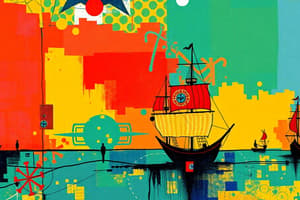Podcast
Questions and Answers
What was the primary function of the astrolabe?
What was the primary function of the astrolabe?
- Track cargo on a ship
- Measure wind speed
- Determine the latitude of a ship at sea (correct)
- Predict storms
Which ship was particularly well-suited for exploration and navigation?
Which ship was particularly well-suited for exploration and navigation?
- Nao
- Schooner
- Caravel (correct)
- Galleon
What was the primary purpose of the nao?
What was the primary purpose of the nao?
- Long-distance voyages (correct)
- Short coastal trips
- Exploring inland rivers
- Trade within Europe
How did latitude measurements assist navigators at sea?
How did latitude measurements assist navigators at sea?
Which instrument was crucial for determining latitude measurements?
Which instrument was crucial for determining latitude measurements?
What role did Portuguese navigation instruments play in the Age of Discovery?
What role did Portuguese navigation instruments play in the Age of Discovery?
Who completed the first direct sea route from Europe to India in 1498?
Who completed the first direct sea route from Europe to India in 1498?
Which Portuguese explorer discovered Brazil in 1500?
Which Portuguese explorer discovered Brazil in 1500?
What motivated Portuguese explorations in the early 16th century?
What motivated Portuguese explorations in the early 16th century?
Which continent did Portuguese explorers NOT reach during the Age of Discovery?
Which continent did Portuguese explorers NOT reach during the Age of Discovery?
Who led the first circumnavigation of the world?
Who led the first circumnavigation of the world?
What was a key motivation for Portugal's exploration efforts?
What was a key motivation for Portugal's exploration efforts?
Flashcards are hidden until you start studying
Study Notes
Portuguese Explorations and Navigation Instruments of 1500
In the early 16th century, the Portuguese were at the forefront of global exploration and navigation. Their explorations and navigation instruments played a crucial role in the Age of Discovery, which led to the establishment of the first global trading network. This article will delve into the key aspects of Portuguese explorations and the navigation instruments used during this period.
Portuguese Explorations
The Portuguese explorations were driven by several factors, including the desire for economic gain, the quest for new trade routes, and the search for new territories. Portugal, a small country with limited resources, saw exploration as a means to expand its influence and wealth. The Portuguese were not the only ones seeking to explore and conquer new lands, but they were one of the most successful in navigating the sea.
Portuguese explorers were instrumental in discovering new sea routes to Asia, Africa, and the Americas. One of the most significant figures in Portuguese exploration was Vasco da Gama, who completed the first direct sea route from Europe to India in 1498. Other notable explorers include Pedro Álvares Cabral, who discovered Brazil in 1500, and Ferdinand Magellan, who led the first circumnavigation of the world.
Navigation Instruments
The Portuguese relied on a variety of navigation instruments to guide their explorations. These instruments included the astrolabe, the caravel, the nao, and latitude measurements.
Astrolabe
The astrolabe was a versatile instrument used for both navigation and astronomy. It was an essential tool for determining the latitude of a ship at sea. The astrolabe consisted of a flat plate with a movable rule that could be aligned with the stars to determine the ship's position.
Caravel
The caravel was a type of ship that was particularly well-suited for exploration and navigation. It was lighter and more maneuverable than other ships of the time, making it ideal for navigating the seas. The caravel's unique design allowed it to sail closer to the wind, enabling Portuguese explorers to explore new areas and reach their destinations more quickly.
Nao
The nao was a larger, more powerful ship used for long-distance voyages. It was typically larger and slower than the caravel but could carry more cargo and provisions. The nao was often used for exploratory voyages and was the ship used by Vasco da Gama on his historic voyage to India.
Latitude Measurements
Latitude measurements were crucial for navigating the sea. The Portuguese used various methods to measure latitude, including the use of the astrolabe and the observation of celestial bodies. By determining the latitude of a ship at sea, navigators could determine their position and plan their course accordingly.
Conclusion
The Portuguese explorations and navigation instruments of 1500 played a significant role in the Age of Discovery. The Portuguese were instrumental in discovering new sea routes, establishing the first global trading network, and expanding their influence and wealth. Their reliance on navigation instruments such as the astrolabe, caravel, nao, and latitude measurements allowed them to explore new lands and reach their destinations more quickly and accurately. These discoveries and innovations laid the foundation for the global exploration and trade that followed in the centuries to come.
Studying That Suits You
Use AI to generate personalized quizzes and flashcards to suit your learning preferences.




